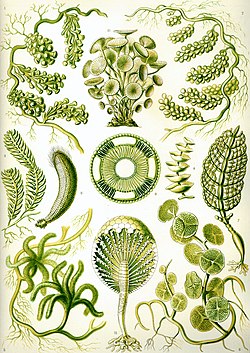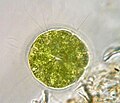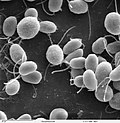Pyrenoids are sub-cellular phase-separated micro-compartments found in chloroplasts of many algae, and in a single group of land plants, the hornworts...
29 KB (3,564 words) - 19:01, 28 May 2025
autospores. Each cell contains a single chloroplast, a variable number of pyrenoids (including lack thereof), and from one to hundreds of flagella without...
48 KB (4,811 words) - 23:12, 6 June 2025
and traditionally has been distinguished mainly through the absence of a pyrenoid. Species of Chloromonas occupy a variety of habitats, including soil, temporary...
6 KB (545 words) - 21:42, 29 November 2024
Chloroplast (section Pyrenoids)
Starch can also accumulate around the pyrenoids when CO2 is scarce. Pyrenoids can divide to form new pyrenoids, or be produced "de novo". Thylakoids (sometimes...
193 KB (19,591 words) - 04:33, 2 June 2025
green chloroplast, their four-flagellate cell bodies, the presence of a pyrenoid within the chloroplast, and a scale-produced thecal-wall. Species within...
19 KB (2,397 words) - 22:30, 23 May 2025
of the monoplastidic species, a cellular structure called a pyrenoid is absent. The pyrenoid is a liquid-like organelle which enables a more efficient photosynthesis...
31 KB (3,170 words) - 03:15, 26 May 2025
of RuBisCO is densely packed into a single subcellular compartment: the pyrenoid. Carbon dioxide is concentrated in this compartment using a combination...
27 KB (3,145 words) - 09:51, 12 June 2025
and compressed. Cells contain a cup-shaped chloroplast with one or more pyrenoids and usually an stigma. Two contractile vacuoles are present at the base...
3 KB (307 words) - 21:20, 1 April 2025
nucleus, a single parietal chloroplast and a single pyrenoid lacking a starch sheath (or no pyrenoid at all). Reproduction occurs asexually by autospores...
4 KB (262 words) - 19:16, 29 November 2024
conspicuous basal pyrenoid surrounded by a starch sheath. The stigma is small, reddish and situated at the base of the cell near the pyrenoid. Cells contain...
4 KB (534 words) - 06:24, 9 June 2025
worldwide. The species name pyrenoidosa refers to the presence of a prominent pyrenoid within the Chlorella chloroplast. Auxenochlorella pyrenoidosa has been...
4 KB (372 words) - 13:56, 10 April 2025
by the lack of a pyrenoid in the chloroplast. This characteristic is unclear as some sources list Didymocystis as having pyrenoids, but some species...
3 KB (283 words) - 05:21, 23 February 2025
lateral or basal chloroplast and an indistinct basal pyrenoid or pyrenoid-like body; the pyrenoid may not be visible in young cells or cultures. Reproduction...
17 KB (1,996 words) - 23:07, 24 May 2025
unequal flagella, a minimum of one chloroplast with three membranes and pyrenoids penetrated by stacks of thylakoids, a robust stigma, a paraflagellar swelling...
16 KB (2,303 words) - 19:26, 23 May 2025
and multiple plates if diplomorphic". The nucleomorphs are never in the pyrenoid, and there is never a scalariform furrow. The cells do, however, have a...
2 KB (104 words) - 19:26, 25 May 2024
base, an eyespot, and a large cup-shaped chloroplast with at least one pyrenoid. The colonies co-ordinate their flagellar movement to create a rolling...
7 KB (707 words) - 00:08, 17 April 2025
presence of pyrenoids is used as an identifying feature of the genus, separating it from other euglenoids, such as Lepocinclis and Phacus. Pyrenoids may be...
35 KB (3,679 words) - 19:06, 2 June 2025
fully circles the cell's circumference. The chloroplast contains a single pyrenoid which is surrounded by a starch envelope. Cells are uninucleate. Older...
6 KB (655 words) - 19:02, 21 May 2025
mucilage. Cells contain a single cup-shaped, parietal chloroplast with one pyrenoid. Chlorococcum reproduces by the formation of autospores or zoospores. The...
6 KB (538 words) - 21:25, 29 November 2024
red) Thylakoids, site of the light-dependent reactions of photosynthesis Pyrenoid, center of carbon fixation Trichocyst Alveolus, surface cavity or pit Thecal...
102 KB (11,034 words) - 21:17, 14 June 2025
be stored as starch granules and paramylon. Paramylon is made in the pyrenoids of Euglena. The euglenoids have chlorophylls a and b and they store their...
3 KB (270 words) - 06:26, 4 June 2025
Cells are cylindrical, with a parietal, plate-like chloroplast without pyrenoids or starch. The nucleus is located in the median constriction of the chloroplast...
3 KB (309 words) - 05:10, 23 February 2025
the cell. Pyrenoids are normally present, but in some conditions (such as in photoheterotrophic medium), some species do not produce pyrenoids. At the center...
10 KB (917 words) - 05:33, 29 March 2025
wall at the distal ends of the raphe Frustule; hard and porous cell wall Pyrenoid; center of carbon fixation Plastid membranes (4, secondary red) Inner membranes...
158 KB (16,258 words) - 09:19, 18 June 2025
hydroxyproline-rich glycoproteins, a large cup-shaped chloroplast, a large pyrenoid, and an eyespot apparatus that senses light. Chlamydomonas species are...
36 KB (3,874 words) - 08:26, 25 May 2025
reticulate, cup-shaped, spiral, or ribbon shaped. They have one or more pyrenoids to preserve protein and starch. The latter chlorophyll type is not known...
117 KB (13,302 words) - 21:50, 19 June 2025
Oedogonium). In many species, there may be one or more storage bodies called pyrenoids (central proteinaceous body covered with a starch sheath) that are localised...
13 KB (1,439 words) - 04:50, 25 May 2025
this genus is characterized by its unique lobed chloroplast that lacks a pyrenoid, differentiating it from other unicellular red algae. It has drawn interest...
5 KB (628 words) - 03:11, 18 May 2025
single chloroplast is present, filling nearly the entire cell; it lacks a pyrenoid. It is commonly used as a bioindicator species to assess the levels of...
3 KB (310 words) - 12:56, 15 April 2024
accumulate within the cell from where they diffuse into the carboxysomes. Pyrenoids in algae and hornworts also act to concentrate CO2 around RuBisCO. The...
110 KB (11,839 words) - 09:07, 20 June 2025























